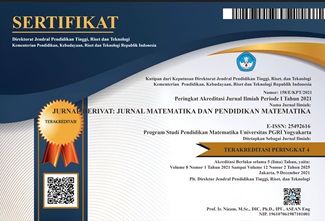Analisis Butir Soal Tes Matematika Materi Trigonometri
DOI:
https://doi.org/10.31316/jderivat.v10i3.5218Abstract
In learning outcomes assessment activities, teachers play an active role in preparing measuring instruments. Competency measurement tools must have appropriate quality criteria used in measuring student competence. This study aims to determine the characteristics of the mathematical competency test instrument in terms of item validity, item difficulty level, item discriminating power and distractor function. The instrument developed is a competency test instrument for trigonometry material. The form of this instrument is multiple choice. The sample of this research is SMA Negeri 5 Yogyakarta. Analysis of the Trigonometry competency test items was carried out using qualitative analysis with the result that 85% in terms of material had good criteria, 82.5% in terms of construction had good criteria and 92.5% in terms of language had good criteria. Quantitative analysis of the Trigonometry competency test shows that 27 items (67.5%) have good validity, the test has a reliability value of 0.709 with good criteria. There were 26 questions (65%) with moderate difficulty level, 28 questions (70%) had good category discrimination, and 37 questions (92.5%) had good criteria for the distraction function.
Keywords: validity, reliability, difficulty level, differentiating power
References
Azwar, S. (2012). Reliabilitas dan validitas edisi 4. Yogyakarta: Pustaka Pelajar.
Hariyanto, & Basuki, I. (2014). Asesmen Pembelajaran Bandung. In Bandung: PT. Remaja Rosdakarya Offset.
Kementerian Pendidikan dan Kebudayaan. (2013). Peraturan Menteri Pendidikan dan Kebudayaan RI Nomor 23 Tahun 2013 tentang Perubahan Atas Peraturan Menteri Pendidikan Nasional Nomor 15 Tahun 2010 tentang Standar Pelayanan Pendidikan Dasar Di Kabupaten/Kota. Menteri Kesehatan Republik Indonesia Peraturan Menteri Kesehatan Republik Indonesia, 69(127).
Lutfianto, Moch., & Sari, A. F. (2017). Respon Siswa terhadap Soal Matematika Mirip PISA dengan Konteks Berintegrasi Nilai Islam. Jurnal Elemen, 3(2). https://doi.org/10.29408/jel.v3i2.342
Mardapi, D. (2008). Teknik Penyususnan Instrumen Tes dan NonTes. In Indonesian Digital Journal of Mathematics and Education.
Mardapi, D. (2017). Pengukuran, Penilaian, dan Evaluasi Pendidikan. Academia Edu, 7(2).
Moore, B., & Stanley, T. (2009). Critical Thinking and Formative Assessments. Critical Thinking and Formative Assessments: Increasing the Rigor in Your Classroom.
Prestasi, M., & Akuntansi, P. B. (2014). Arikunto, Suharsimi. 2012. Dasar-Dasar Evaluasi Pendidikan. Jakarta: Bumi Aksara. Universitas, 137.
Sari, E. F. P. (2015). Pengembangan soal matematika model PISA untuk mengetahui argumentasi siswa di Sekolah Menengah Pertama. Jurnal Pendidikan Matematika, 9(2).
Tshabalala, T., & Ncube, A. C. (2014). Teachers’ perceptions on the causes and effects of highrate teacher-turnover of mathematics and science teachers in rural secondary schools - a case study of Nkayi District. International Journal of Innovation and Applied Studies, 8(1).
Arifin, Zainal. (2016). Evaluasi Pembelajaran: Prinsip, Teknik, Prosedur Cet. 8. Bandung: PT Remaja Rosdakarya
An, D., Instrument, A., Higher, O. F., & Thinking, O. (n.d.). Pengembangan Instrumen Asesmen Higher Order Thinking Skill (HOTS) ... (Agus Budiman, Jailani) - 139, 1(November 2014), 139–151.
Brookhart, S. (2010). How to assess Higher Order Thinking Skills in your classroom. Alexandria: VA: ASCD.
Fanani, M. Z. (2018). Strategi pengembangan soal hots pada kurikulum 2013. Edudeena, 2(1), 57–76.
Gais, Zakkina, dkk. (2017). Analisis kemampuan siswa dalam menyelesaikan soal high. Mosharafa, 6(2), 255–266.
Makur, A. P. dkk. (2018). Kemampuan berpikir tingkat tinggi. Jurnal Pendidikan Matematika, 12(2), 5–24.
Munayati, Zulva, Zulkardi, dan S. (2015). Kajian soal buku teks matematika kelas X Kurikulum 2013 menggunakan framework PISA. Jurnal Pendidikan Matematika, 9(2), 188–206.
Nitko, A.J. dan Brookhart, S. M. (2011). Educational assessment of students: Xth edition. New Jersey: Prentice Hall Eglewood Cliffs.
OECD. (2016). PISA 2015 Result in Focus. (Online), (www.oecd.org), diakses 9 Januari 2019.
Sudijono, Anas. (2015). Pengantar Evaluasi Pendidikan Ed. 1, Cet. 14. Jakarta: PT RajaGrafindo Persada
Sugiyono. (2015). Metode Penelitian Pendidikan (Pendekatan Kuantitatif, Kualitatif, dan R&D) Cet. 21. Bandung: CV Alfabeta
Sukirman. (2012). Pengembangan Sistem Evaluasi. Yogyakarta: Insan Madani
Shafizan Sabri, Item Analysis of student Comprehensive Test for Reasearch Teaching Begiliner String Ensemble Using Model Based Teaching Among Music Students In Public Universities”, International Journal of Rducation and Reasearch, 1 (12), hlm. 1.
Simalango, M. M. (2018). Kesulitan siswa dalam menyelesaikan soal-soal PISA pada konten change and relationship level 4, 5, dan 6 di SMP N 1 Indralaya. 12(1), 43–58.
Downloads
Published
Issue
Section
Citation Check
License
Copyright (c) 2023 M.M Endang Susetyawati, Bintang Wicaksono

This work is licensed under a Creative Commons Attribution-ShareAlike 4.0 International License.
Authors who publish with this journal agree to the following terms:
-
Authors retain copyright and grant the journal right of first publication with the work simultaneously licensed under a Creative Commons Attribution-ShareAlike 4.0 International License that allows others to share the work with an acknowledgment of the work's authorship and initial publication in this journal.
- Authors are able to enter into separate, additional contractual arrangements for the non-exclusive distribution of the journal's published version of the work (e.g., post it to an institutional repository or publish it in a book), with an acknowledgment of its initial publication in this journal.
- Authors are permitted and encouraged to post their work online (e.g., in institutional repositories or on their website) prior to and during the submission process, as it can lead to productive exchanges, as well as earlier and greater citation of published work (See The Effect of Open Access).







